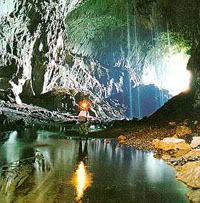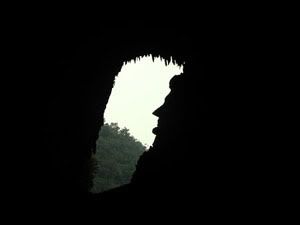With its rainforest abundant wildlife, jungle streams, waterfalls, interesting plant life, secluded beaches and trekking trails, Bako offers visitor an excellent introduction to the rainforest of Borneo. Bako may not have an instanly recognisable star attraction but there can be very few places in the world that pack so much natural beauty into such a limited area, all its sheer range of attractions and activities have made Bako one of the most popular parks in Sarawak.
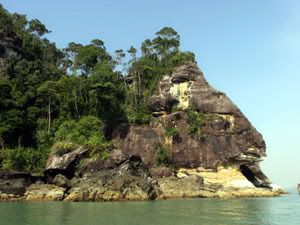 Cliff by the sea
Gazetted as a protected area on 1st May 1957 and was published to public on 4th may 1957. Bako is Sarawak's oldest national park, covering an area of 2,727 hectares at the tip of the Muara Tebas peninsula. It is one of the smallest national park in Sarawak, yet one of the most interesting as it contains almost every type of vegetation found in Borneo. A well maintained network of trails from wasy forest strills to full day jungle treks, allows visitors to get the most out of this unique environment.
Cliff by the sea
Gazetted as a protected area on 1st May 1957 and was published to public on 4th may 1957. Bako is Sarawak's oldest national park, covering an area of 2,727 hectares at the tip of the Muara Tebas peninsula. It is one of the smallest national park in Sarawak, yet one of the most interesting as it contains almost every type of vegetation found in Borneo. A well maintained network of trails from wasy forest strills to full day jungle treks, allows visitors to get the most out of this unique environment.
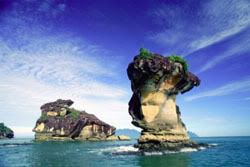 The unique stone tower
The Rainforest And Other Vegetation
Bako contains an incredible variety of plant species and vegetation types and this is one of the park's great attractions. At Bako it is possible to see almost every type of vegetation found in Borneo. 25 distinct types of vegetation from seven complete eco-system, Beach vegetation, Cliff vegetation, Kerangas or heath Forest, Mangrove Forest, Mixed Dipterocarp Forest, Padang or Grasslands Vegetation and Peat Swamp Forest. It is wasy to explore these eco-system via the jungle trails. The contrasts are so distinct that you do not have to be scientist to notice the differences. Furthermore, most of the different vegetation types are found close to the Park Office at Telok Assam. Amongst the unique and strange plant life are the carnivorous plants (pitcher plants, sundews, bladderworts).
The unique stone tower
The Rainforest And Other Vegetation
Bako contains an incredible variety of plant species and vegetation types and this is one of the park's great attractions. At Bako it is possible to see almost every type of vegetation found in Borneo. 25 distinct types of vegetation from seven complete eco-system, Beach vegetation, Cliff vegetation, Kerangas or heath Forest, Mangrove Forest, Mixed Dipterocarp Forest, Padang or Grasslands Vegetation and Peat Swamp Forest. It is wasy to explore these eco-system via the jungle trails. The contrasts are so distinct that you do not have to be scientist to notice the differences. Furthermore, most of the different vegetation types are found close to the Park Office at Telok Assam. Amongst the unique and strange plant life are the carnivorous plants (pitcher plants, sundews, bladderworts).
 Jetty through the swamp peat forest
Jetty through the swamp peat forest
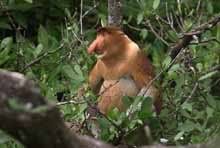 Proboscis Monkey,a rare and endangered species which can only be found in Borneo!
Read more; http://www.forestry.sarawak.gov.my/forweb/np/np/bako.htm
Proboscis Monkey,a rare and endangered species which can only be found in Borneo!
Read more; http://www.forestry.sarawak.gov.my/forweb/np/np/bako.htm
 Cliff by the sea
Gazetted as a protected area on 1st May 1957 and was published to public on 4th may 1957. Bako is Sarawak's oldest national park, covering an area of 2,727 hectares at the tip of the Muara Tebas peninsula. It is one of the smallest national park in Sarawak, yet one of the most interesting as it contains almost every type of vegetation found in Borneo. A well maintained network of trails from wasy forest strills to full day jungle treks, allows visitors to get the most out of this unique environment.
Cliff by the sea
Gazetted as a protected area on 1st May 1957 and was published to public on 4th may 1957. Bako is Sarawak's oldest national park, covering an area of 2,727 hectares at the tip of the Muara Tebas peninsula. It is one of the smallest national park in Sarawak, yet one of the most interesting as it contains almost every type of vegetation found in Borneo. A well maintained network of trails from wasy forest strills to full day jungle treks, allows visitors to get the most out of this unique environment.
 The unique stone tower
The Rainforest And Other Vegetation
Bako contains an incredible variety of plant species and vegetation types and this is one of the park's great attractions. At Bako it is possible to see almost every type of vegetation found in Borneo. 25 distinct types of vegetation from seven complete eco-system, Beach vegetation, Cliff vegetation, Kerangas or heath Forest, Mangrove Forest, Mixed Dipterocarp Forest, Padang or Grasslands Vegetation and Peat Swamp Forest. It is wasy to explore these eco-system via the jungle trails. The contrasts are so distinct that you do not have to be scientist to notice the differences. Furthermore, most of the different vegetation types are found close to the Park Office at Telok Assam. Amongst the unique and strange plant life are the carnivorous plants (pitcher plants, sundews, bladderworts).
The unique stone tower
The Rainforest And Other Vegetation
Bako contains an incredible variety of plant species and vegetation types and this is one of the park's great attractions. At Bako it is possible to see almost every type of vegetation found in Borneo. 25 distinct types of vegetation from seven complete eco-system, Beach vegetation, Cliff vegetation, Kerangas or heath Forest, Mangrove Forest, Mixed Dipterocarp Forest, Padang or Grasslands Vegetation and Peat Swamp Forest. It is wasy to explore these eco-system via the jungle trails. The contrasts are so distinct that you do not have to be scientist to notice the differences. Furthermore, most of the different vegetation types are found close to the Park Office at Telok Assam. Amongst the unique and strange plant life are the carnivorous plants (pitcher plants, sundews, bladderworts).
 Jetty through the swamp peat forest
Jetty through the swamp peat forest
 Proboscis Monkey,a rare and endangered species which can only be found in Borneo!
Read more; http://www.forestry.sarawak.gov.my/forweb/np/np/bako.htm
Proboscis Monkey,a rare and endangered species which can only be found in Borneo!
Read more; http://www.forestry.sarawak.gov.my/forweb/np/np/bako.htm